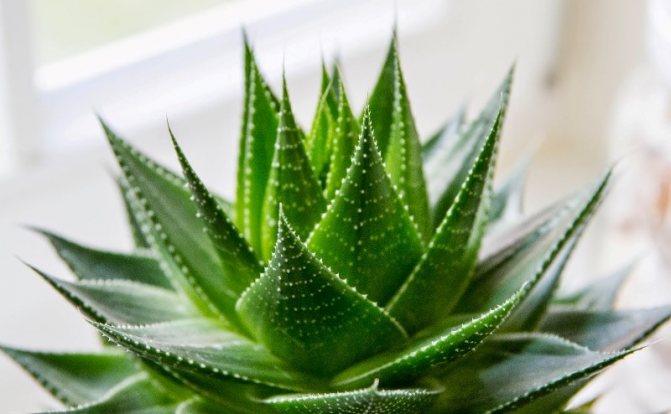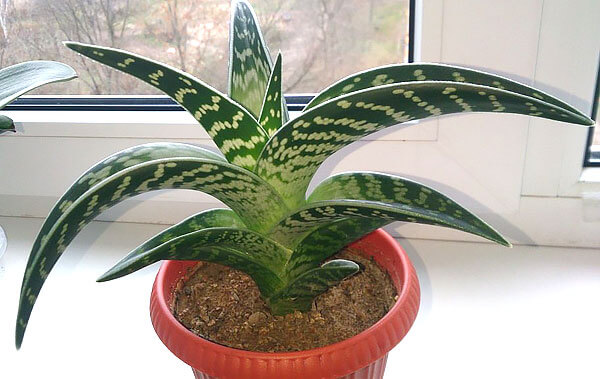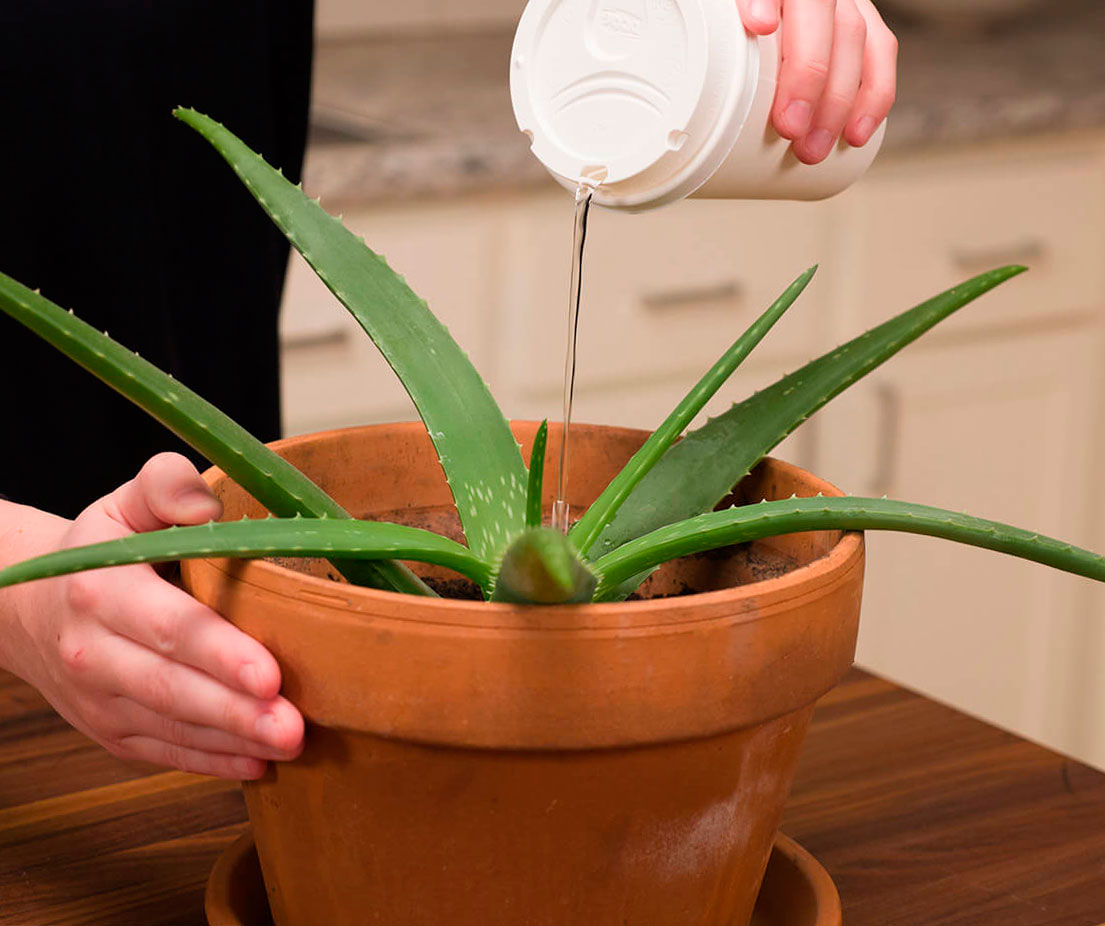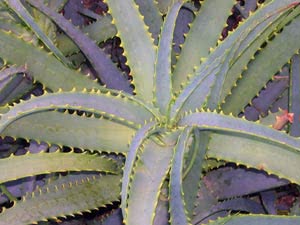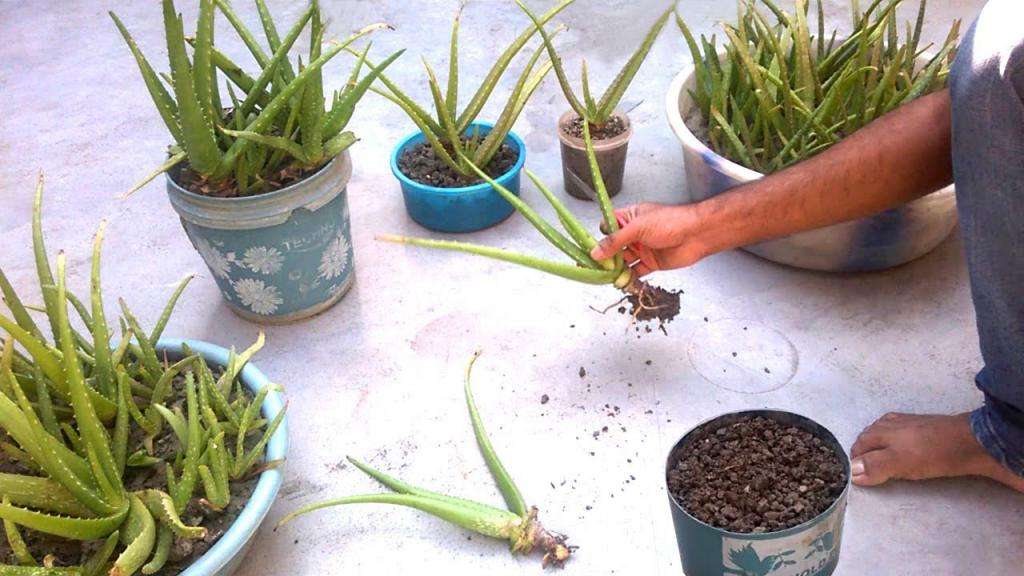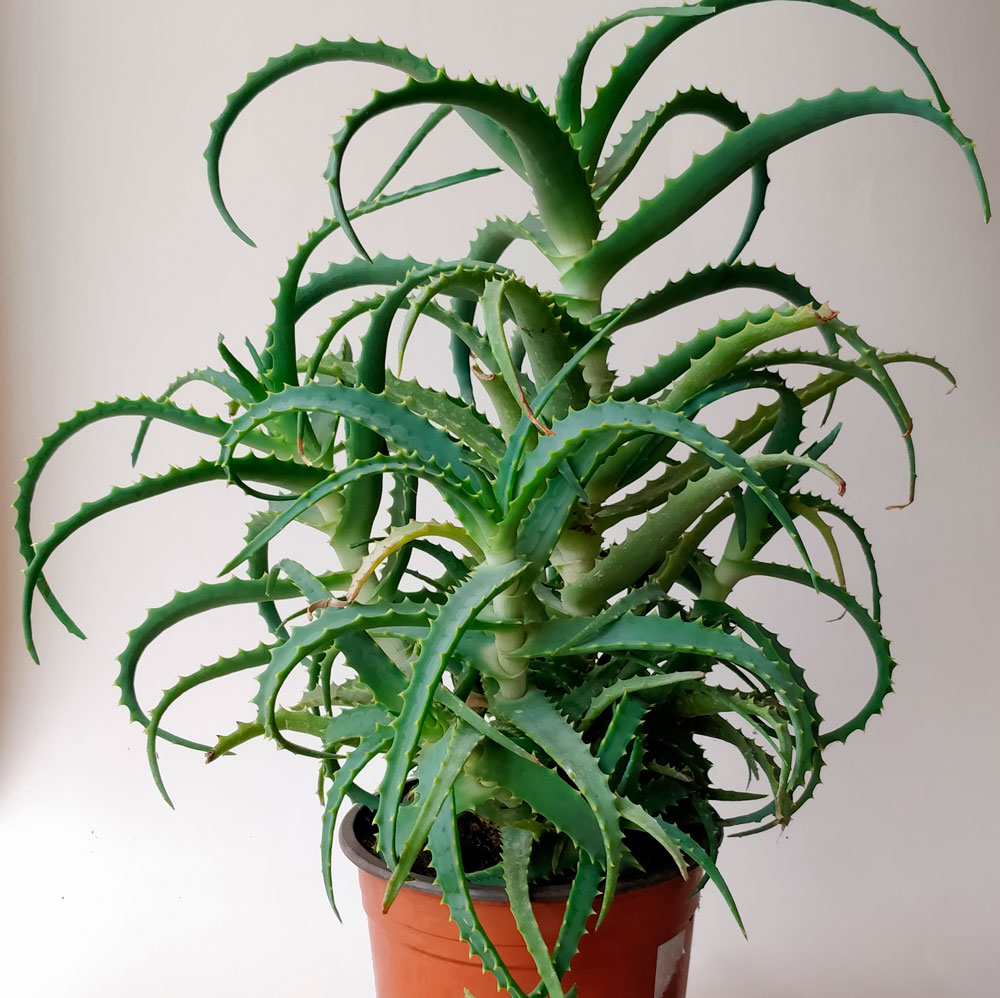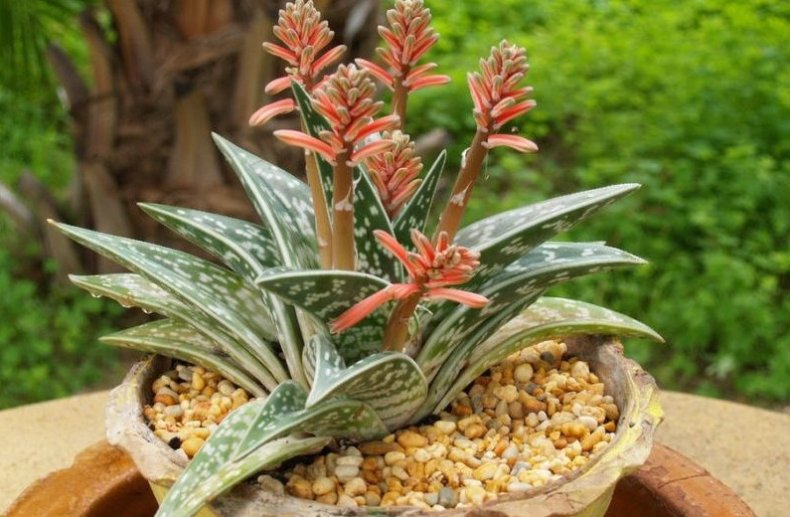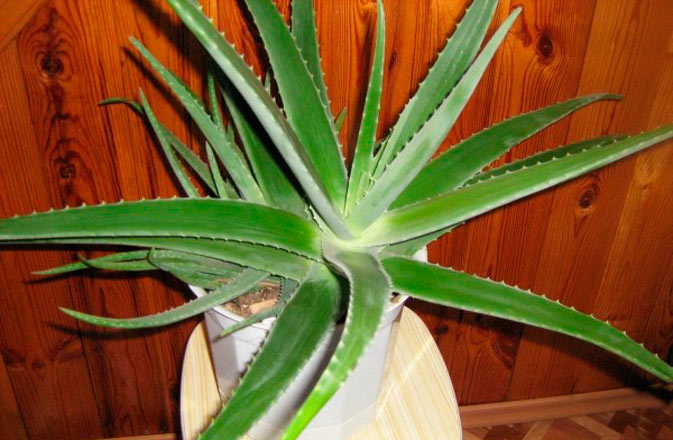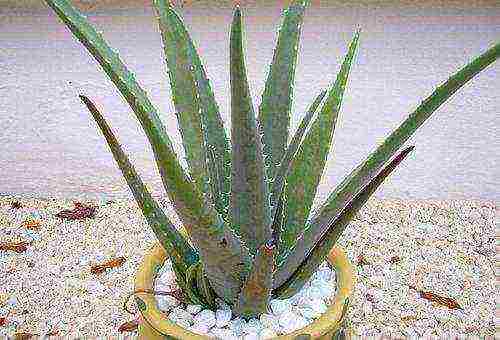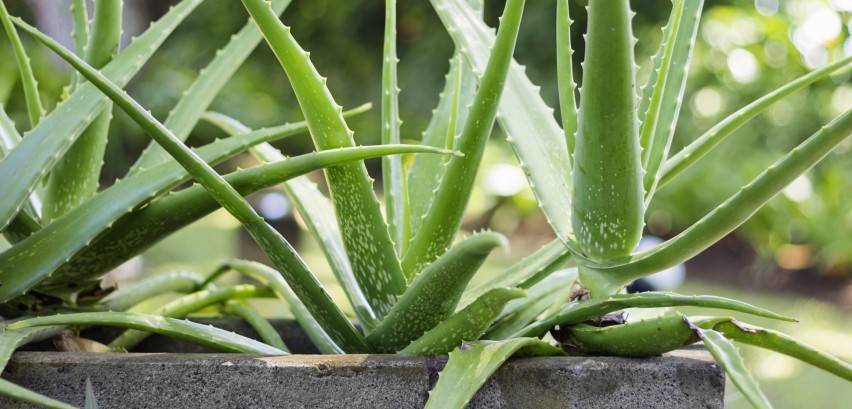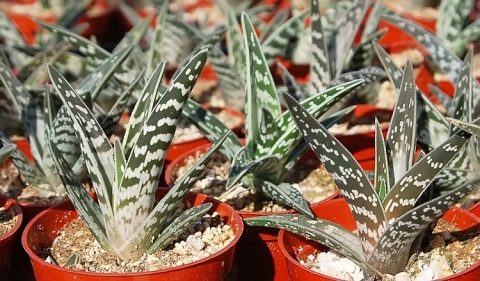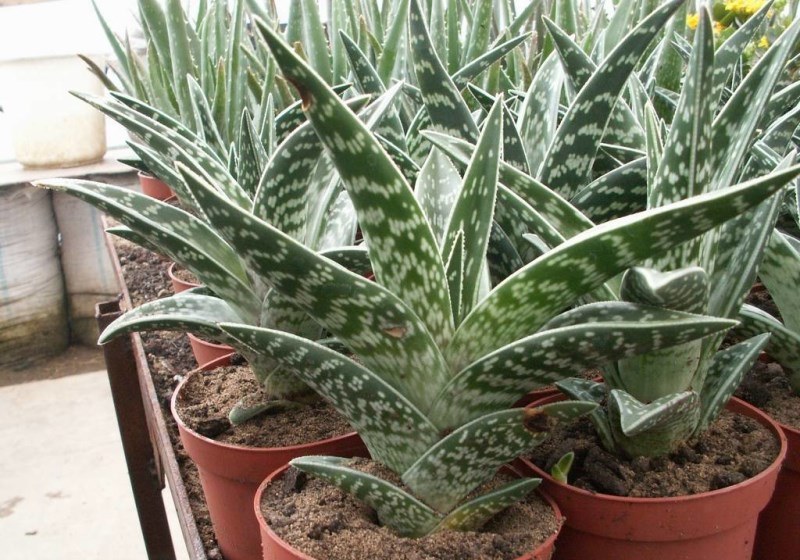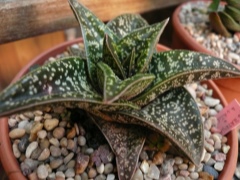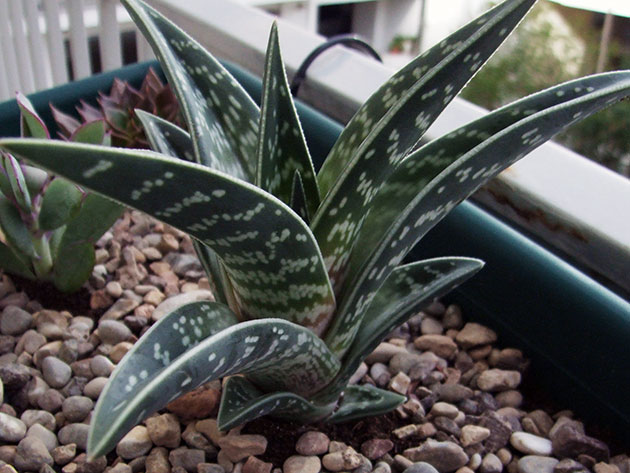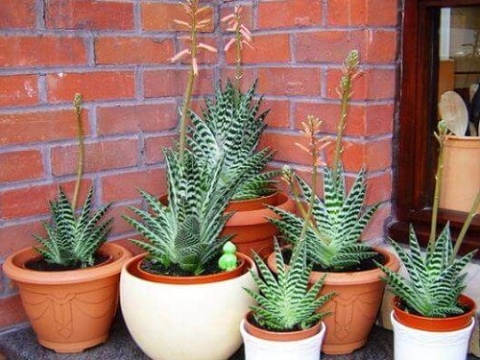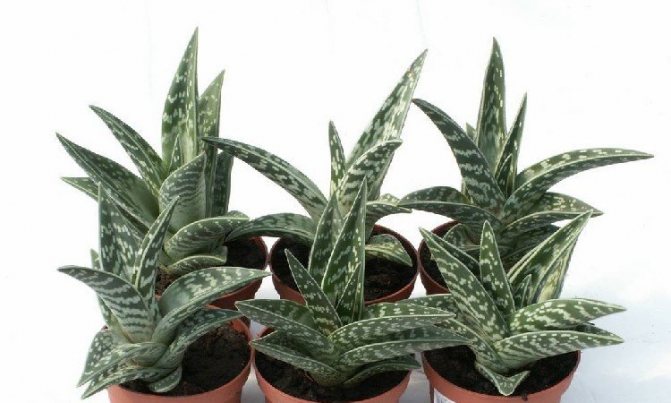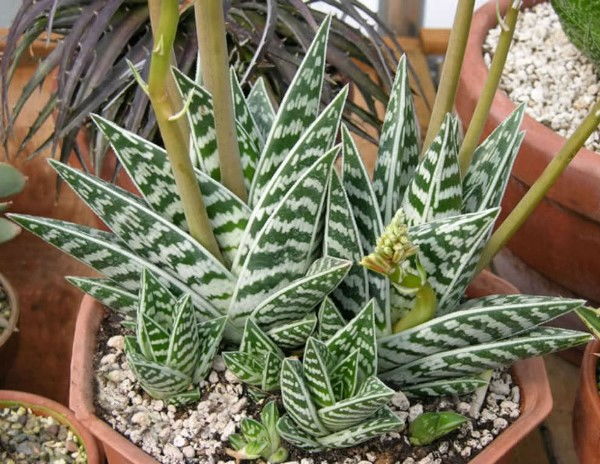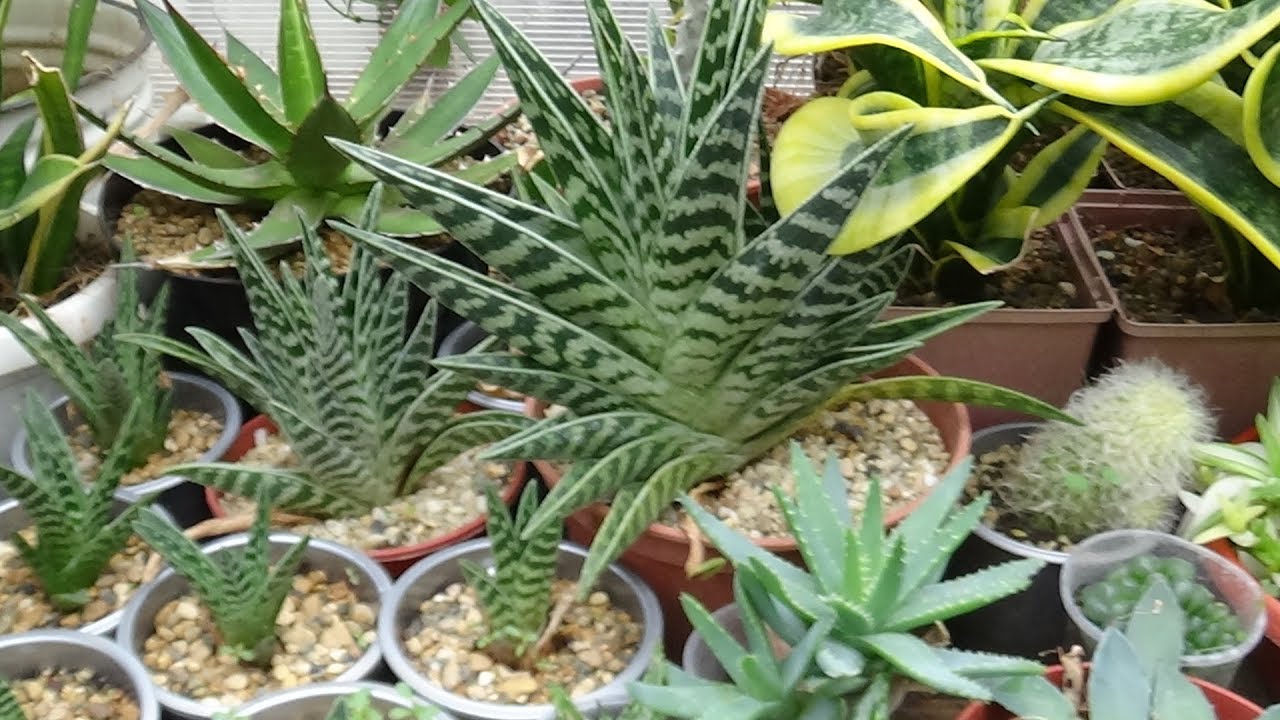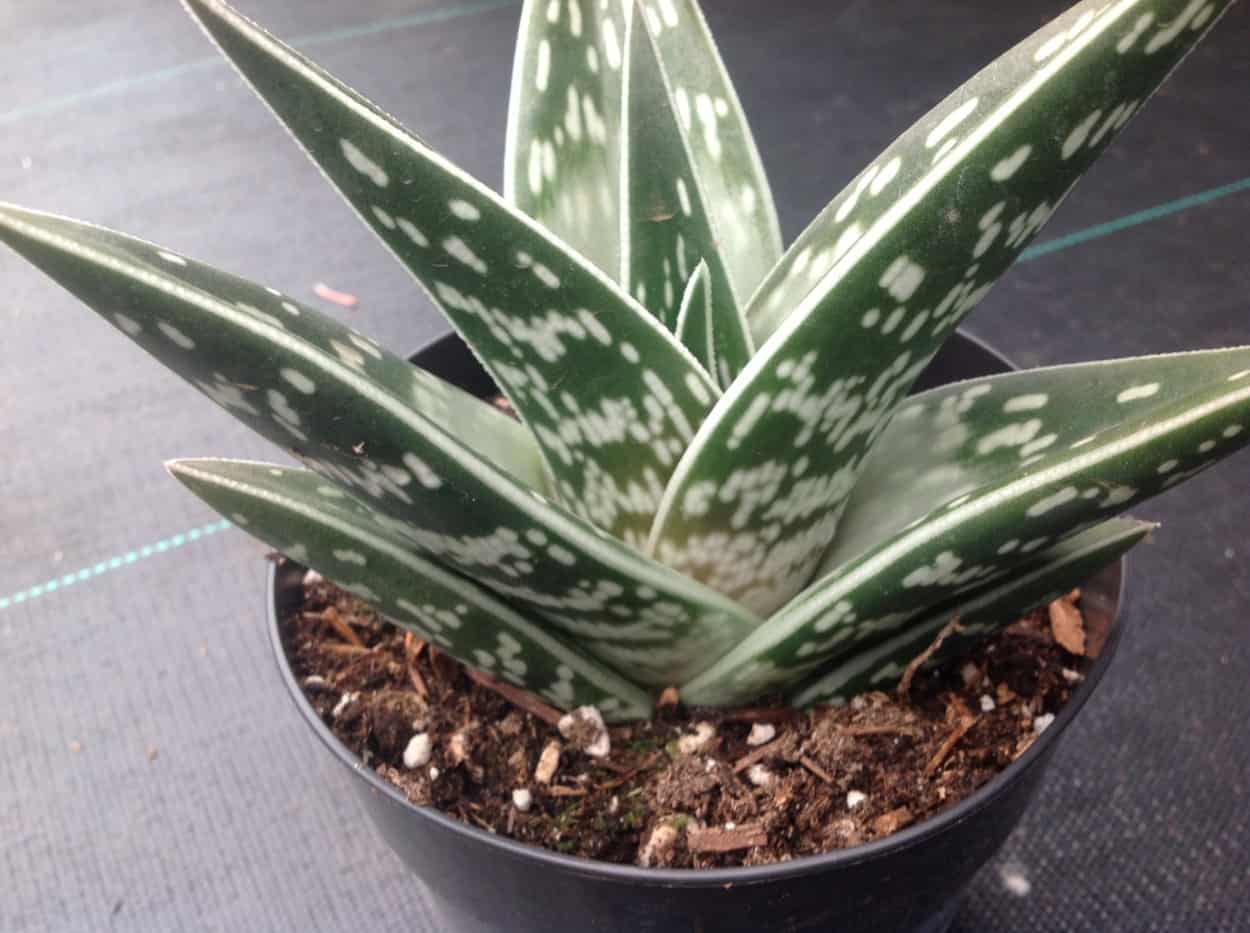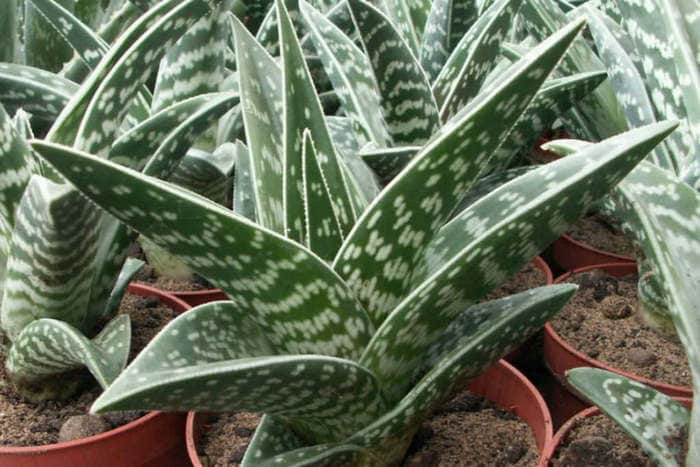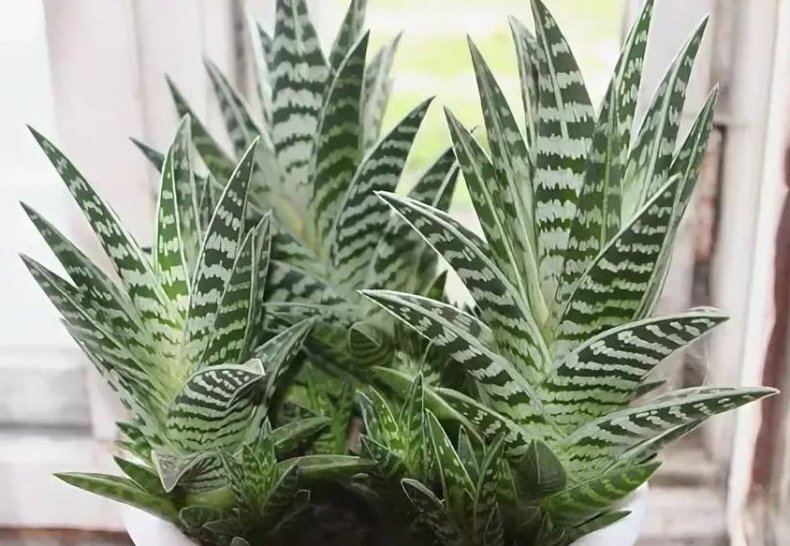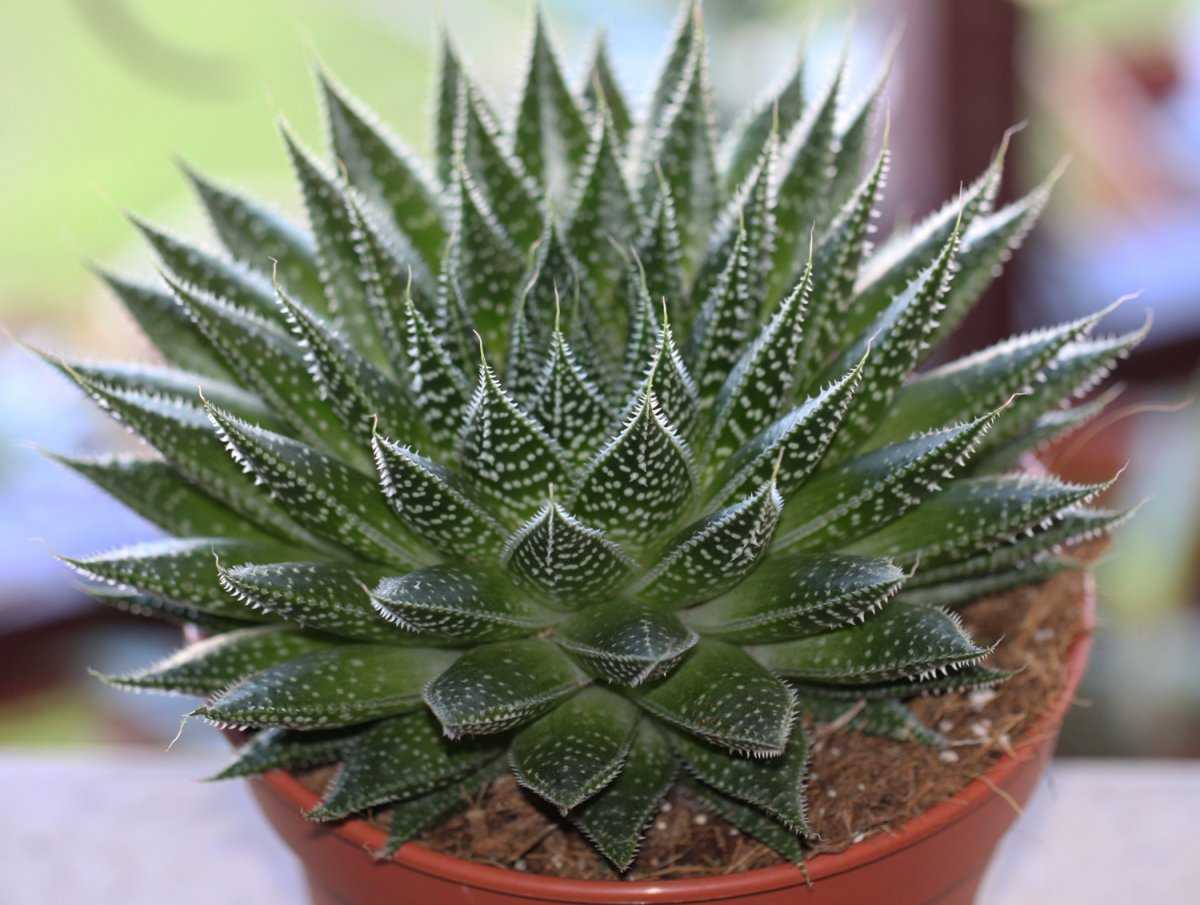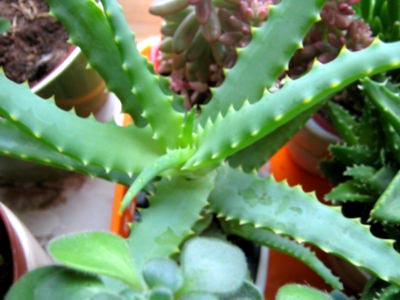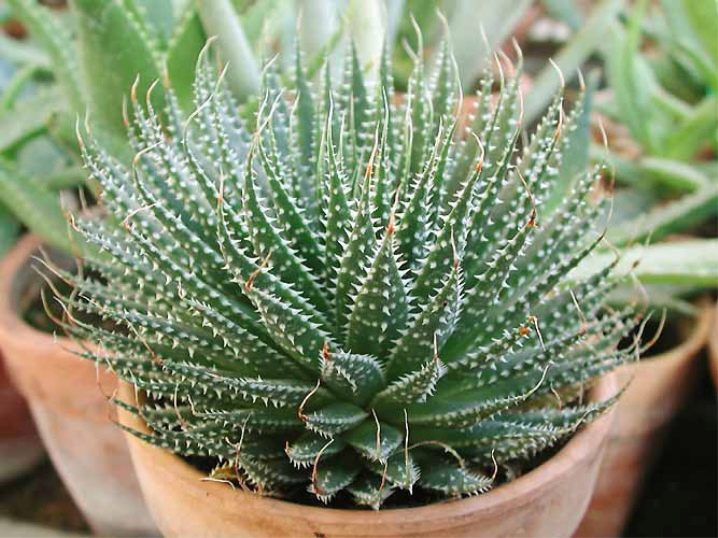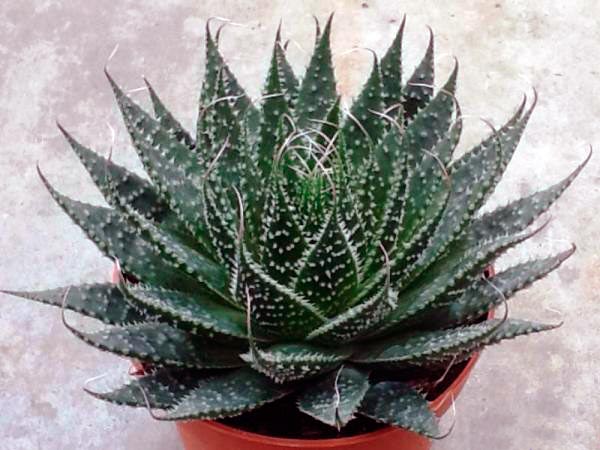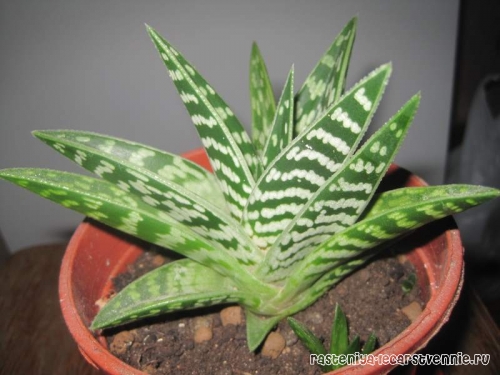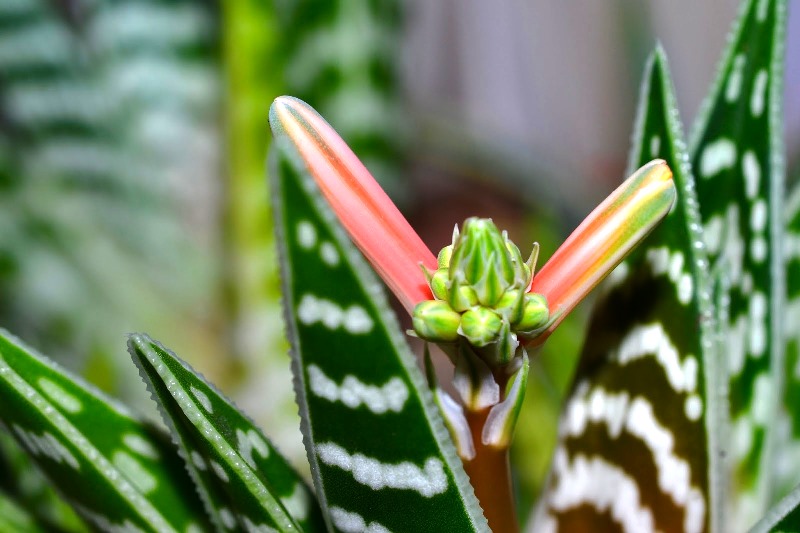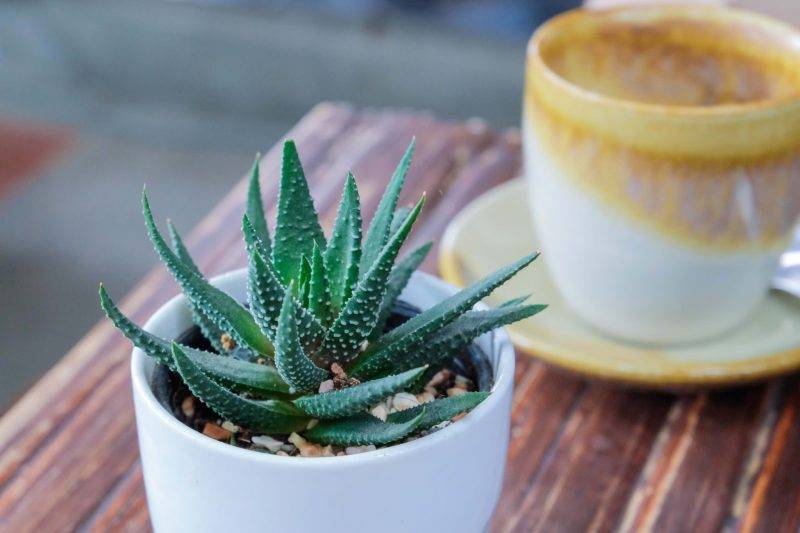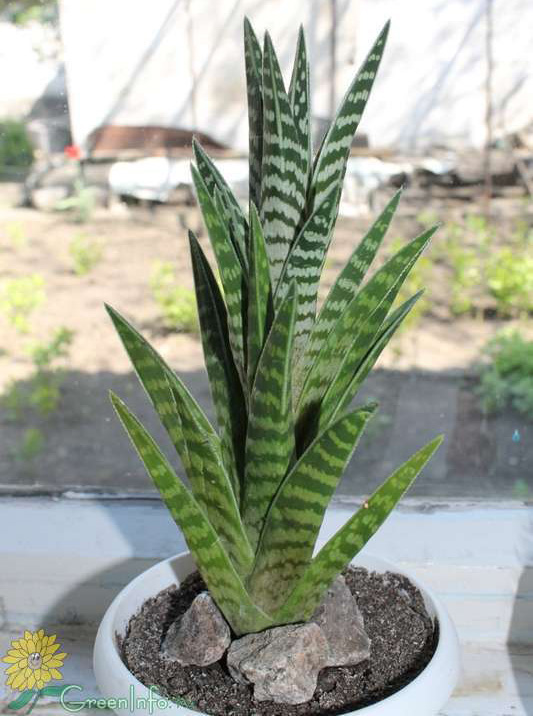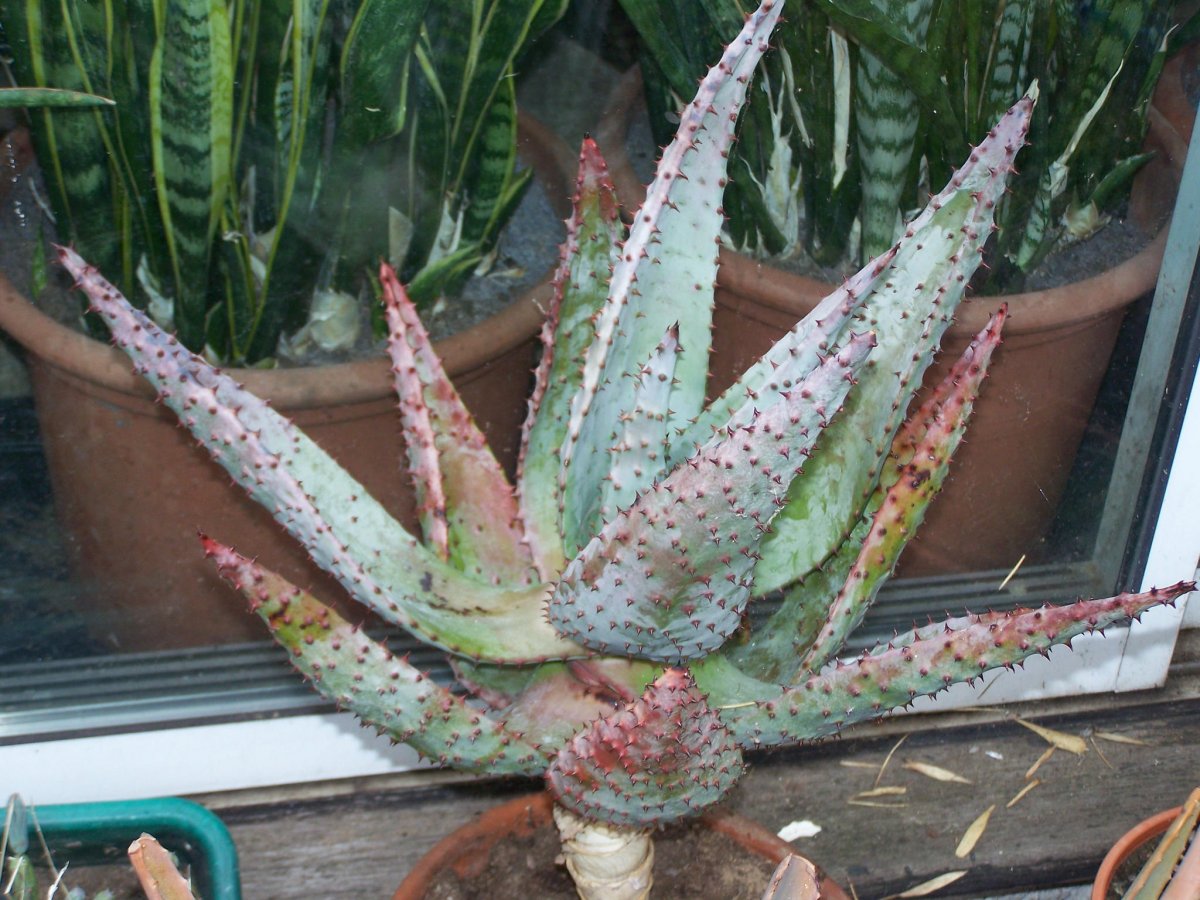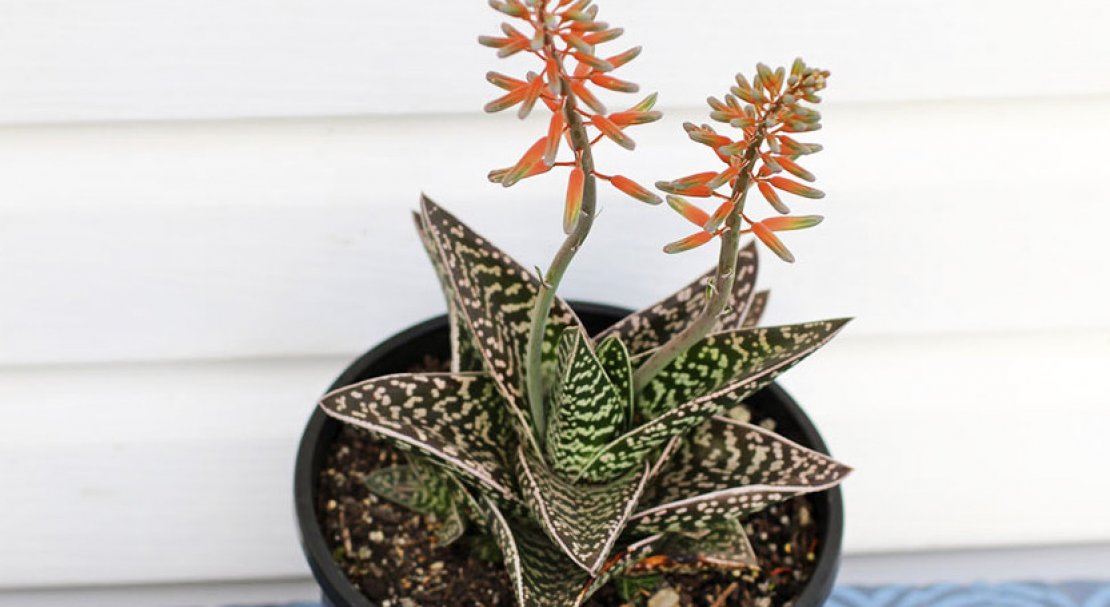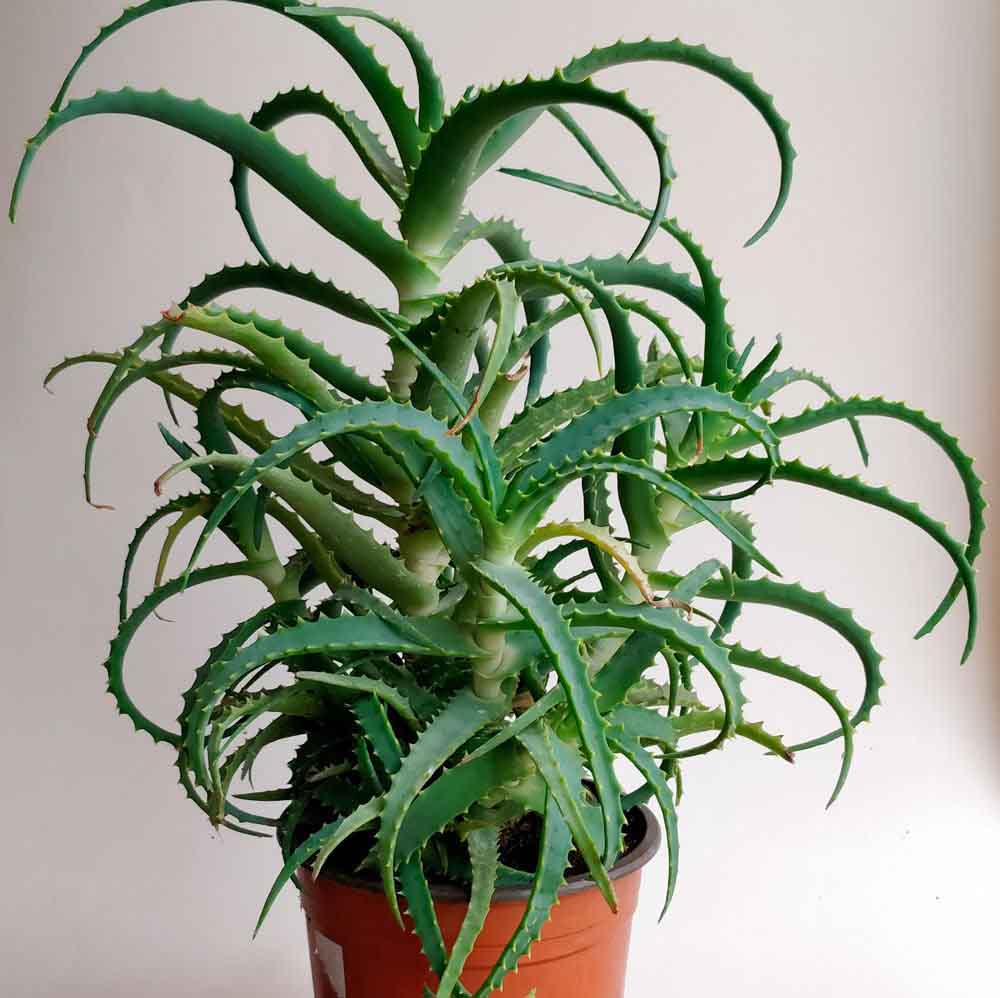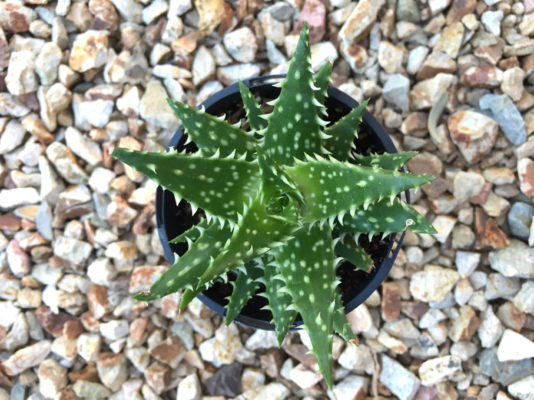Growing problems
Aloe tree-like, or agave, unfortunately, often suffers in our apartments. Rather, it is grown for medicinal purposes, is regularly plucked and cared for little. But if you grow this plant correctly, and do not cut off its leaves, you can get very beautiful specimens.
Most often, aloe suffers from excess moisture, if watering is too frequent, the roots rot, the plant dies. Aloe also often suffer from a lack of sunlight, especially in winter. At the same time, their stems are stretched, the leaves are smaller and sit on the trunk less often. On the contrary, on the western or southwestern window sills, aloe can lose its decorative effect - the leaves turn red and thin, but it is worth rearranging to a more gentle sun (east side or northwest), the bush turns green again.
Does not benefit this plant and planting in heavy clay soil. Moisture evaporates poorly in it, and there is no aeration, and long-term drying out of the soil inevitably leads to the formation of rot.
If you ask about pests, any granny who grows an agave will be surprised - most likely, she has not heard that he has pests. And if something is wasting away, then we will root the branch and grow a beautiful bush again. In fact, pests can appear on aloe - mealybugs and scale insects. Both are easy to spot. The scale insects look like white cotton balls in the axils of the leaves, under the husk from old dead leaves on the trunk, and the scale insects are visible on the leaves shriveled from lack of moisture and nutrition as brownish pimples, sometimes translucent. If you notice something similar on aloe, you need to thoroughly rinse the plant, wipe it with a soapy sponge. Then rinse, spray and pour with a solution of actara. Repeat the treatment in a week.
Home care
In the care of aloe, an unpretentious plant.
Landing
For planting, the soil left over from the transplantation of any plants can be used.
An important rule is the addition of sand to the soil and the use of drainage from crushed bricks, shards or expanded clay.
The pot is selected low with a wide diameter.
The plant is transplanted annually.
Transfer after purchase
If the aloe was purchased in a transport container, then it is transplanted into a pot of a suitable size.
Watering
In the warm season, the plant is watered as the earth dries up. Drying can be determined by the lightness of the pot.
In winter, watered 2 times a month. If the room is cool, then watering is cut back to once a month.
The water should be at room temperature and must have settled for about 10 hours.
Water must be served carefully, pouring it under the leaves and not allowing it to get between the leaves. This can cause a decay process.
Air humidity
The humidity level of the air does not really matter. Spraying aloe is not necessary, rather it is even harmful if water gets into the outlet, which can stagnate there and cause damage to the plant.
Temperature regime
Feels good at temperatures from 18 to 26 degrees. In summer, it can be taken out to the balcony for better development in a constant supply of fresh air.
In winter, the temperature in the room should not drop below 10 degrees. Otherwise, the plant will die.
Growth per year
The growth of spinous aloe is due to the development of new leaves, up to 6-10 of them can be formed per year.
Life span
In indoor conditions it will live from 5 to 20 years. Life expectancy depends on third-party factors, primarily on care.
Bloom
Flowering occurs in late spring - early summer. Aloe produces a peduncle, which produces beautiful orange tubular flowers.
At the end of flowering, the peduncle must be cut off.
The dormant period continues throughout the fall and winter.
Lighting
Aloe needs good lighting. It should be displayed in a sunny place.
With a lack of lighting, the likelihood of flowering decreases.
Fertilizer
You need to feed aloe in the summer. Top dressing is done every month with fertilizers designed for succulents.
Priming
Aloe does not need a special soil composition, but the addition of sand is mandatory. Drainage from expanded clay or broken brick is laid from below.
You can get acquainted with the most popular types of aloe in a separate article. Also read the materials of our experts about the peculiarities of growing variegated, tree-like and aloe vera at home.
How to care for variegated (tiger) aloe
Provide the necessary conditions for the plant before caring for the tiger aloe.
In the summer they prefer the temperature regime in the range from 12 to 18 ° C, in the winter - the usual room temperature. For a comfortable growth of aloe tiger, the room or territory must be well lit. When caring for a variegated aloe, watering in summer requires moderate watering, in winter it is noticeably reduced, and the plant is kept cool
At the same time, it is important to avoid excessive waterlogging of the soil, and it is advisable to keep the air humidity at a minimum level. Aloe is fed with variegated when leaving at home in spring and autumn about once a month, fertilizers are used for flowering plants
Aloe tiger has rather strong roots, so transplanting is regularly carried out using more spacious containers: adult plants are transplanted with a break of 1-2 years, young plants - annually. Reproduction of variegated aloe is carried out by rooting the apical and lateral shoots, which are pre-cut and dried for at least two days. When planting in a pot, they must be tied to a support. It is not recommended to water the plant in the first week after planting. It is best when caring for tiger aloe to spray the leaf plate twice, and sometimes even three times a day, using a spray bottle. Pests of this plant are extremely rare.
Description of the flower
The plant belongs to the asphodelic family. The list of its varieties includes more than five hundred species of perennials. Their predominant number belongs to herbaceous, but there are also shrubs. A number of species are tree-like.
In homes, aloe is a common plant. The popularity of the plant was created not only by its medicinal properties, but also by other qualities. In particular, the fact that all species belong to succulents and xerophytes, easily tolerating drought.
The stems of the plant are not very high. Moisture accumulates in the leaves of aloe. That is why they are so thick and fleshy. Aloe leaf shape is oblong with notches, sharp thorns or cilia. Some species have a smooth edge. During growth, the shoot is covered with leaves in a spiral, which contributes to the formation of dense rosettes.
Important! Aloe flowers are small, tubular. They can have a variety of colors, including reds, yellows, oranges, white tones.
During the flowering period, the formed flowers are collected in a brush and are located on a long peduncle.
Most often in homes you can find aloe vera, it is sometimes called aloe real. Most home gardeners value the color for its expressiveness and medicinal qualities. In addition to this type of aloe, as you know, there are many other species that are divided into two main groups. One contains medicinal plants, the other contains decorative plants.
Decorative types include:
- Aloe is variegated. It is a bushy plant. The height of an adult bush is up to 30 centimeters. Shortened stem, long triangular leaves. Has a two-colored spotted color. In spring, aloe blooms with bright inflorescences that have an orange or scarlet tone.

Variegated view
- Aloe spinous. Small bush.Numerous narrow leaves are gray-green in color. Additionally decorated with white speck. When it blooms, it forms a pedicel on which tubular, pale orange inflorescences are located.
- Aloe Marlota. It is an evergreen shrub that is best kept in large houses or greenhouses, since its actual height is up to 4 meters. The plant has been described as having large, broad leaves on which reddish thorns are found. The flowers are bright yellow or orange.
In addition to the indicated types of aloe, decorative has many other varieties with various names. The decorative view may be referred to as:
- folded;
- squat;
- dichotomous;
- strongly branched;
- cap-shaped;
- pretty;
- white-flowered;
- havortia-like
- chernokolyuchkov;
- set apart.
Important! Despite the fact that decorative species are devoid of medicinal qualities, they have an attractive leaf shape, a varied color of their surface and beautiful flowering, while providing the necessary care conditions. Among the medicinal species, most home gardeners know the aloe agave.
But besides him, other species have similar qualities, which include plants with the following names:
Among the medicinal species, aloe agave is known to most home gardeners. But besides him, other species have similar qualities, which include plants with the following names:
- soapy;
- Barbadian;
- tree-like;
- frightening.

As well as decorative varieties, medicinal varieties are distinguished by their appearance, therefore, before purchasing a certain variety, it is worth familiarizing yourself with its features through catalogs and the Internet.

Tree view
How to propagate aloe
Tiger scarlet can be propagated in two ways: with the help of shoots or with the help of seeds. Consider both methods in more detail.
Escapes
This method is preferred by novice florists, as it is quite simple to perform. For its implementation, it is necessary to take shoots, the length of which should not be less than 7 centimeters, after which they must be dried without fail 24-48 hours.
Then the bases of the shoots must be lubricated with charcoal and a specialized rooting machine. Next, the planting process takes place. It is imperative to use a support to which the young shoot is attached. Within a week, the plant will take root in the soil.
Seeds
Reproduction of variegated aloe seeds is considered more laborious and more time-consuming. Before placing the seeds in the soil complex, you need to soak them in an aqueous solution of potassium permanganate. In order to place the seeds in the ground, they need to be slightly pressed inward. After that, they need to be covered with foil. In such a greenhouse, the seeds should be kept until the first young leaves appear.
However, it is important to remember that the film must be opened periodically to avoid condensation.
Thus, observing all the rules for caring for a flower, you can get a healthy and incredibly beautiful plant that will bring benefit and joy to all family members.
For information on how to transplant variegated Aloe, see the video below.
Aloe is easy to reproduce due to its ability to quickly take root and its unpretentiousness. Under natural conditions, reproduction occurs by seeds and shoots growing from the roots. It is unlikely that you will be able to get seeds at home, but if you wish, you can buy aloe seeds in specialized stores.
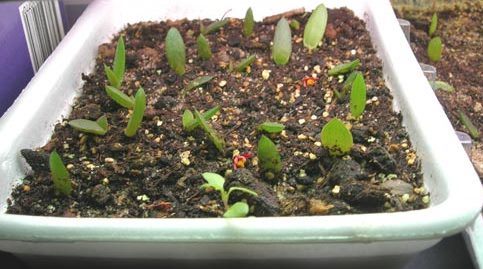
Aloe from seeds
Seedlings are placed in a bright place with an air temperature of about 21 degrees. The ground must be periodically moistened with a spray bottle so as not to damage the sprouts, and ventilated. Seedlings with four leaves must be dived, transplanted into the same substrate. The grown sprouts are transplanted into separate pots.
At home, it is easier and easier to propagate an agave in the following traditional ways:
- shoots;
- cuttings;
- top;
- sheet.
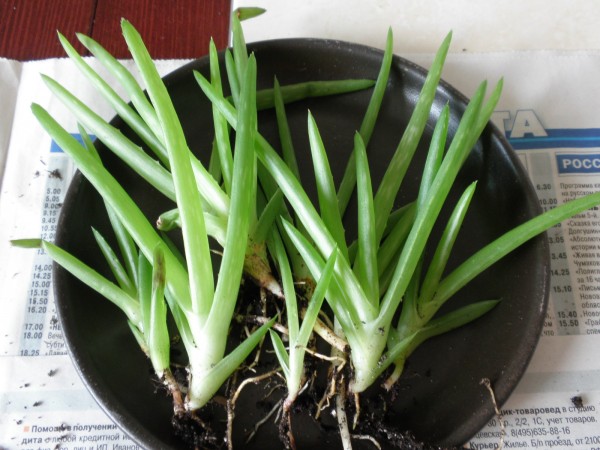
Aloe shoots
Shoots (babies) grow at the very root and have their own root system. It is necessary to carefully separate them with a sharp knife, air dry until the cut dries. Then the cut is sprinkled with crushed activated carbon. For planting during reproduction, it is recommended to use a land mixture composed of sand and leafy earth in equal proportions.
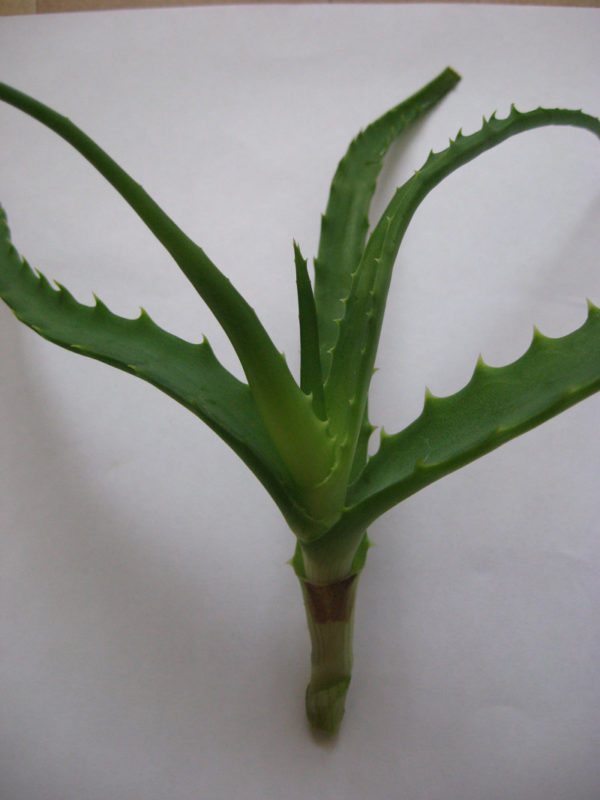
Alohe stalk
Cuttings grow from the main trunk, between the leaf and the trunk. Aloe can be propagated by cuttings at any time of the year. They are cut or broken off near the trunk itself, then left to dry in a dark place for five days. The place of the cut is sprinkled with fine charcoal or activated carbon. After the cut has dried, the cuttings are planted in sand or an earthen mixture prepared according to the proportions indicated above. The roots will germinate in about a week and the new plants can be transplanted into succulent potting mix.
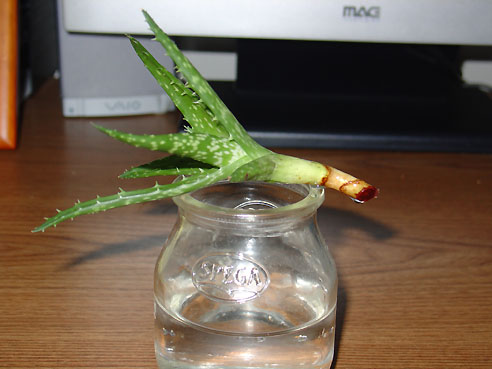
Rooting the top of the aloe
For propagation of aloe, the top is cut off so that 6-7 leaves remain on the handle. The leaves are removed from the bottom. The top is placed in a jar or glass of water so that the water covers the lower part without leaves. After the formation of roots, the sprout is transplanted into a pot with an earthen mixture.

Leaf propagation
How to fertilize a houseplant correctly?
At the moment, fertilizers are broadly divided into two types:
- Root dressing - should be watered directly under the root of the plant.
- Foliar top dressing - the entire outer part of the flower (leaves, stem, etc.) is sprayed from a spray bottle.
For aloe, the first option is more suitable, since chemical burns often remain on the leaves from the second. Moreover, it is not even necessary to sprinkle carefully and a little - the composition of foliar dressings itself is rarely suitable for aloe.
At home, it is best to feed aloe from May to August, when the fastest growing phase of the plant begins. It is at this time that the aloe will absorb the best obtained fertilizers, and then immediately convert the obtained vitamins and minerals into growth and juice for the leaves.
Succulent plants need to be fed no more often than once every 1-2 weeks.
Many beginners mistakenly pour fertilizer onto dry soil. This is a mistake - watering should be done only after the soil is well moistened. If this is not done, fertilizer can, on the contrary, harm the root system, and not deliver useful substances to it.
Almost all fertilizers include:
- ammonium nitrate;
- superphosphate;
- potassium salt and ammonium sulfate.
In addition, the following components remain very important for the plant:
- Nitrogen. It is he who is responsible for the green color of the succulent, because nitrogen is involved in the procedure for the production of chlorophyll. Due to the increased production of "green" leaves acquire a healthy and strong appearance, and their growth is significantly accelerated.
- Phosphorus is needed for budding, color, root and leaf growth. With a lack of phosphorus in the plant, you can observe spots on the leaves, changing color, slow growth.
- Potassium is needed mainly as a conductor of nitrogen - without it, the circulation of nitrogen, carbon dioxide and the production of oxygen are extremely slow. We can say that it is potassium that converts carbon dioxide into oxygen. In its absence in the composition of the plant, one can observe a characteristic white "edge" along the contour of the leaves, as well as a conspicuous change in the color of the succulent.
- Magnesium is also important for photosynthesis. Without it, the rich green color of the succulent is lost and faded.
For flowering
In achieving this goal, the preparation "Gilea" for cacti and succulents is very effective. It is rich in nitrogen, potassium, phosphorus, magnesium and a number of other useful substances. You can feed them both before and during the flowering of aloe - in both cases it has a positive effect on the rate of bud formation, their splendor, brightness and overall growth of the succulent.
Mode of application:
- Moisten the soil slightly with plain water.
- Take 1 liter of purified water (filtered or purchased sealed).
- Pour exactly 2 caps of Gilea into this liter.
- Mix everything thoroughly.
- Water the flower under the root.
In general, it is not recommended to use organic fertilizers, since the succulent digests them very poorly.
For fast growth
The general consensus among gardeners is that Bona Forte is ideal for accelerating succulent growth. It is designed for cacti, but due to the closeness of the two plant species, it also perfectly fertilizes aloe. The drug stimulates and strengthens the growth of plants, their immunity and healthy color. The composition contains as standard:
- magnesium, potassium, phosphorus, nitrogen, etc .;
- a distinctive feature is the addition of succinic acid to the composition.
Mode of application:
- Take 1.5 liters of clean water.
- Measure out 5 ml Bona Forte and add to water.
- To stir thoroughly.
- Pour at the root.
You can store the finished liquid, but no longer than three weeks from the date of manufacture.
In the future, its shelf life expires, and it will be dangerous to use the concentrate for the succulent.
Flowering and dormant period of the plant
It is believed that it is very difficult to achieve flowering of aloe at home. The main reason that the plant does not bloom is considered to be the lack of long daylight hours and sufficient coolness. These conditions are fundamental to the state of rest. You can hope for flowering only if you provide the plant with the necessary rest. This can be achieved if you apply additional means that provide conditions close to those that contribute to the appearance of flowers.
The list of such tools includes a special lamp that gives additional illumination to the color.
In addition, it is important to remember the rules of care. Observe the number of waterings in the warm and cold periods, feed on time, maintain the required temperature in the room

Bloom
Aloe blooms at home infrequently. To wait for flowering, you need to recreate the annual cycle of the plant in conditions as close as possible to its natural habitat, providing it with impeccable care. In nature, the flowering period of aloe is up to six months. Coloring, depending on the species, varies from scarlet to pale yellow and white.
Note! Most ornamental aloe varieties only begin to bloom at the age of ten or later, so don't rush to expect flowers. To enjoy blooming next spring, you need to prepare in advance:
To enjoy blooming next spring, you need to prepare in advance:
In the month of March, start feeding aloe regularly in accordance with the rules described above. In the summer, when the nights are warm, take it out into the fresh air, gradually increasing the time spent on the veranda or balcony. Do not forget about timely watering. Starting from the September cold snaps, it is necessary to stop "external forays" and place a pot of aloe on a well-lit windowsill
It is important to raise the temperature of the water for irrigation six to eight degrees above the temperature in the room. In winter, you need to prepare a cool and dry place for the plant, where it could wait out the dormant period, so the window sill above the battery is not the best place for wintering.
At the same time, the lighting level can be maintained with fluorescent lamps. With the arrival of spring, the temperature in the room should be increased, stimulating the awakening of the flower. At this time, it is advisable not to disturb him with any movements and turns of the pot. Watering should be done twice a week.
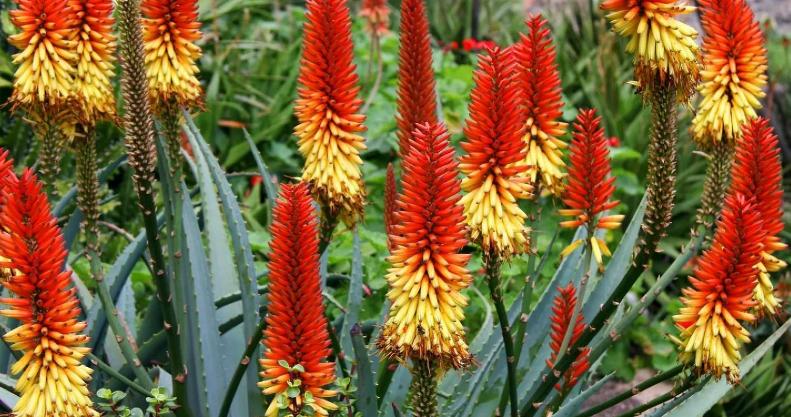
How aloe blooms
Aloe: pests
Aloe is attacked by both specialized, "succulent" pests, obviously imported from natural habitats, and non-specialized ones. The key to a successful fight is the correct and timely determination of the type of pest.Most pests are visible with the naked eye, but some can only be seen with a magnifying glass.
The main diseases can be: root rot and dry rot.
Root rot
Usually, damage occurs when the content is incorrect, too humid, especially in cool weather. The plant can be saved only with early diagnosis of the disease.
 Aloe root rot
Aloe root rot
Root decay causes a long delay in the growth of aloe (especially during the growing season), drying out of the stem, and lack of response to watering.
If root decay is only partially removed, all affected parts of the roots are removed, and the rest are well sprinkled with coal powder or sulfur and aloe is planted in fresh soil with a large proportion of sand
After three weeks, watered very carefully. If the roots are completely rotten, you can save the top of the stem by rooting it like a stalk.
At the same time, part of the stem is cut off so that only healthy strong tissues remain.
Dry rot
The disease occurs when the plants are not maintained correctly.
Outwardly, it does not appear for a long time, while rot is not observed. The plant seems to dry out, without noticeably changing color and shape, but it turns out to be completely dry inside. And all this happens so quickly that the period of "partial defeat" is usually not noticed.
 Dry rot on aloe
Dry rot on aloe
Since this disease is fleeting and methods of dealing with it have not yet been invented, the plant dies. However, disease can be prevented by periodically prophylactic spraying with a systemic fungicide.
Botanical description
Aloe vera often grows up to four meters in height. It has branched, densely leafy, erect stems. Aloe leaves are alternate, up to 40 centimeters long, have hard cartilaginous teeth at the edges. They differ in the presence of very fleshy and juicy pulp. The flowers are large, orange, six-membered, with thin pedicels, forming a cylindrical multi-flowered raceme about 40 centimeters long. Aloe fruit is a capsule with a lot of seeds.
Growing indoors, aloe usually blooms from February to March. The fruits that appear do not ripen.
The homeland of aloe vera is the islands of Curacao and Barbados, the southwestern part of the Arabian Peninsula. The plant is cultivated in Asia and Africa, in the Antilles. In many countries of the world, it is grown as an ornamental garden and home plant.
Collection and harvesting of aloe. Are they fresh Aloe vera is widely used in both folk and traditional medicine. They are usually harvested as they grow. From the juice in the leaves of the plant, condensed aloe juice is obtained by evaporation, which is called sabur in medicine. High-quality sabur is completely soluble in 70% alcohol, worse - in water, gasoline and ether, it does not dissolve at all in chloroform. The pharmaceutical industry makes a number of preparations from liquid aloe juice, and also produces fresh juice with the addition of a small amount of alcohol.
Aloe vera is widely used in both folk and traditional medicine. They are usually harvested as they grow. From the juice in the leaves of the plant, condensed aloe juice is obtained by evaporation, which is called sabur in medicine. High-quality sabur is completely soluble in 70% alcohol, worse - in water, gasoline and ether, it does not dissolve at all in chloroform. The pharmaceutical industry makes a number of preparations from liquid aloe juice, and also produces fresh juice with the addition of a small amount of alcohol.
Fresh aloe juice can be obtained at home. For this, juice is squeezed out of the fleshy lower leaves, which is immediately used for its intended purpose. There is also a known method for preparing aloe in the form of a syrup, which is cooked from the juice of a plant with the addition of sugar and a solution of ferrous chloride.
general information
The variegated aloe was brought to Russia from faraway South America. There, this plant grows in natural conditions, in particular - on stony soils. In nature, aloe of this variety can reach 35 centimeters in height. In general, the plant has a lot of useful properties, which is why it has become so popular. So, aloe is often used in folk medicine.
The tiger species of the plant differs from other subspecies of aloe in some characteristic features. For example, botanists highlight the unusual growth process as well as the original arrangement of the leaves. These plant elements, having a spiral arrangement, grow in 3 rows.The leaves are rather large: 15 cm long and 5 cm wide.
The second important feature of the variegated aloe is its coloring. Despite the fact that the base and main color of the leaves is green, they are covered with light spots along their entire length.
Thanks to these marks, this aloe variety got its unusual name. Like other species of a similar flower, tiger aloe has small and weakly pronounced thorns along the edges of its leaves, which are a kind of visiting card of the plant.
The variegated flower is capable of blooming. In the spring season, flowers on a long stem are knocked out from the very center of the aloe. Their color is yellow-orange, and in size the inflorescences themselves reach 3 centimeters.
This very beautiful, ornamental plant grows up to 25-35 cm at home. The leaves are triangular, arranged in a three-row spiral and form a small neat rosette.
The color is variegated, consisting of symmetrical white stripes and spots. On the edge of each leaf there is a bright white edging with small rounded teeth.
The homeland of the Aloe Variegated (Tiger) is the arid, semi-desert plains of South Africa.

